Model Primitive |
ModelPrimitive is a primitive that can load and render glTF 2.0, COLLADA and AGI's MDL models. glTF and COLLADA are industry standard formats. MDL is the 3D model format used by STK. We recommend using glTF or COLLADA models. Models can be downloaded from AGI's website.
The following code sample demonstrates creating and loading a model:
ModelPrimitive model = new ModelPrimitive(modelUri); EarthCentralBody earth = CentralBodiesFacet.GetFromContext().Earth; Cartographic position = new Cartographic(Trig.DegreesToRadians(39.88), Trig.DegreesToRadians(-75.25), 5000.0); model.SetPositionCartographic(earth, position);
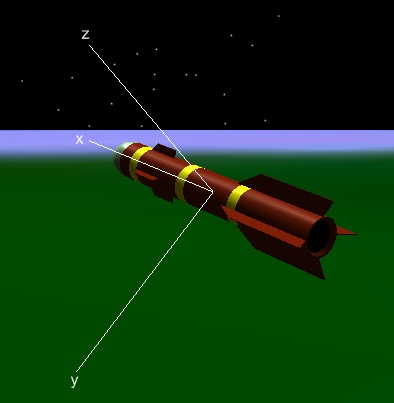
The orientation of the model depends on the model itself. For example, in the hellfire.dae model, the missile is laid out lengthwise along the positive x axis. To change the orientation, use the Orientation property and provide a quaternion that defines the rotation from the model's local axes to the axes of the reference frame in which the model's position is defined. In this case, the model's position is defined in the central body's fixed frame. A convenient way to compute the quaternion is shown below:
Cartographic center = new Cartographic(Trig.DegreesToRadians(-75.25), Trig.DegreesToRadians(39.88), 0.0); PointCartographic origin = new PointCartographic(earth, center); Axes axes = new AxesNorthEastDown(earth, origin); AxesEvaluator axesEvaluator = GeometryTransformer.GetAxesTransformation(axes, earth.FixedFrame.Axes); UnitQuaternion q = axesEvaluator.Evaluate(TimeConstants.J2000); ElementaryRotation r = new ElementaryRotation(AxisIndicator.Second, Math.PI / 2); q = q.Multiply(r); model.Orientation = q;
A topographic axes is created based on the model's position where the x axis point in the local north direction, the y axis points in the local east direction and the z axis points in the local down direction. A quaternion that defines the rotation from these axes to the fixed frame axes is created. To point the model in the local up direction, the quaternion is rotated 90 degrees around the y axis.
Like orientation, the size of the model depends on the model itself. To change the size of the model, use the Scale property. After a model is initialized, its position can be changed using the Position property.
COLLADA models also support raster streams. See the Video Streams on Models topic for more information.
The model primitive supports model articulations, which allow different parts of the model to be rotated, scaled, and/or translated. If the model supports articulations, they can be accessed through the Articulations property.
An example of how to modify the ModelTransformation of a model's ModelArticulation is shown below:
// Create the model and set the position. ModelPrimitive model = new ModelPrimitive(modelUri); EarthCentralBody earth = CentralBodiesFacet.GetFromContext().Earth; Cartographic position = new Cartographic(Trig.DegreesToRadians(-116.75), Trig.DegreesToRadians(36.0), 25000.0); model.SetPositionCartographic(earth, position); // Modify the roll and yaw of the entire model so that the model appears to be parallel // with the horizon. This method is only to demonstrate how articulations can be used. // the preferred method is to set the model's orientation. model.Articulations["Commuter"]["Roll"].CurrentValue = Trig.DegreesToRadians(234.0); model.Articulations["Commuter"]["Yaw"].CurrentValue = Trig.DegreesToRadians(-25.0); // Modify the spin of the propellers. model.Articulations["props"]["Spin"].CurrentValue = Trig.DegreesToRadians(135.0);
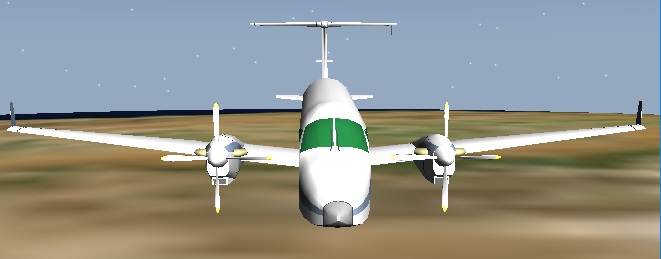
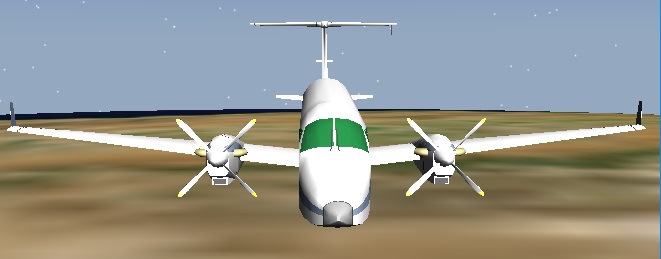
The Articulations property contains an instance of ModelArticulationCollection. ModelArticulationCollection implements IEnumerable<T> and contains a collection of ModelArticulations. ModelArticulation also implements IEnumerable<T> and contains a collection of ModelTransformations. Both the ModelArticulationCollection and ModelArticulation classes accept either an integer or string index to access its values. Use the CurrentValue property to set the value of the transformation, as shown in the code above. The type of transformation can also be retrieved using the Type property, which returns a ModelTransformationType.
Collada models also support the ColladaFX framework, which allows users to write GLSL code to calculate vertex positions, pixel colors, etc. This allows for models to exhibit lighting properties of materials such as metal, glass, plastic, etc. ColladaFX also allows changing OpenGL States, use of all supported OpenGL Texture types (1D, 2D, 3D, cubemap, rectangle, shadow), and render to texture for use with multipass rendering techniques.
The following image shows a satellite that uses a metallic BRDF based on the work of Ashikhmin and Shirley. The paper can be found here This example can be seen in the HowTo example under "Primitives" -> "Models" -> "Draw a Collada model with user defined lighting"
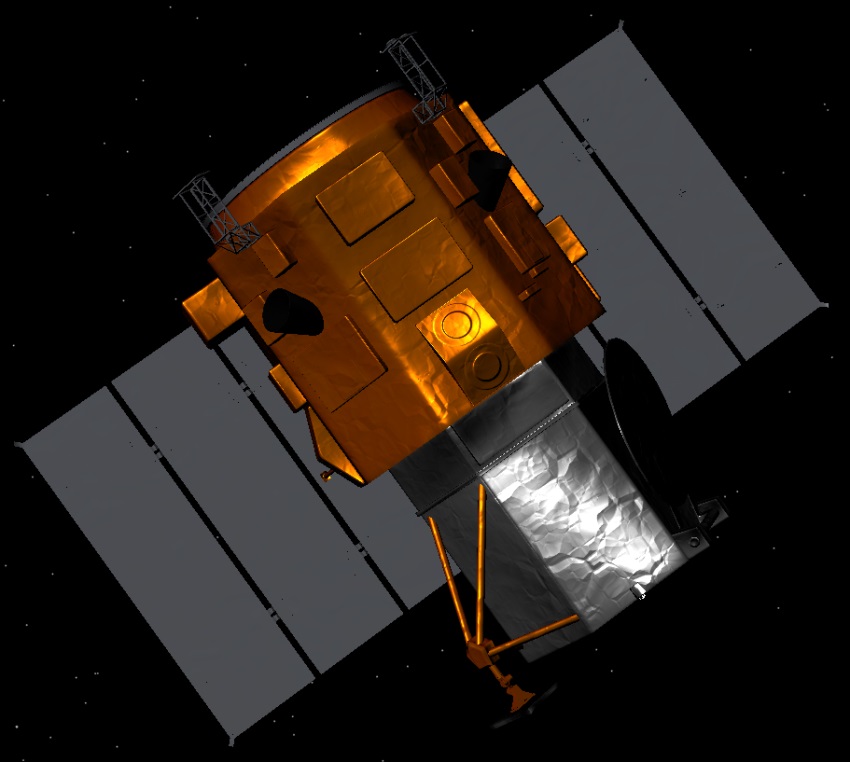
Within your shader code, you have access to scene data that is useful for shading your model. We refer to these as Preset Uniforms because they are accessed as uniform variables in your vertex or fragment shader. These variables must be declared as uniforms and then can be used. Here is an example using Insight3D's animation time to move a vertex.
uniform float agi_Time; uniform float fullOffset; // Vertex Shader that oscillates from position to position+fullOffset along the Z axis. void main() { // Get fractional part of time float t = fract(agi_Time); // Move apply modelview and projection vec4 pos = gl_ModelViewProjectionMatrix * gl_Vertex; // Move vertex a certain percentage of offset pos.z += fullOffset * t; // Set position gl_Position = pos; }
Preset Uniforms
Preset Uniform | Type | Description |
|---|---|---|
agi_ActiveLights | bool[gl_MaxLights] | Light i is active if agi_ActiveLights[i] is true and inactive if false. Light properties can be accessed through gl_LightSources. |
agi_CameraPosition | vec3 | Position of the camera relative to the model's reference frame. |
agi_CentralBodyDepthTexture0, agi_CentralBodyDepthTexture1, ..., agi_CentralBodyDepthTexture7 | sampler2D | A texture that contains the depth values after rendering the CentralBody. The number binds the texture to a particular texture unit. See images below. |
agi_LightingEnabled | float | 1 if lighting is enabled and 0 otherwise. |
agi_LODGeometricToleranceOverDistance | float | When multiplied by the distance from the vertex or fragment to the viewer, the result is the geometric error in world space. |
agi_LODNegativeGeometricToleranceOverDistance | float | Negative of agi_LODGeometricToleranceOverDistance. |
agi_ModelViewMatrix | mat4 | Model-View matrix. |
agi_ModelViewMatrixRelativeToCameraPosition | mat4 | Model-View matrix relative to the camera position. |
agi_ModelViewMatrixRelativeToPrimitiveCenter | mat4 | Model-View matrix relative to the model's center. |
agi_ModelViewProjectionMatrix | mat4 | Model-View-Projection matrix. |
agi_ModelViewProjectionMatrixRelativeToCameraPosition | mat4 | Model-View-Projection matrix relative to the camera position. |
agi_ModelViewProjectionMatrixRelativeToPrimitiveCenter | mat4 | Model-View-Projection matrix relative to the model's center. |
agi_OrthographicProjectionMatrix | mat4 | Orthographic projection matrix. |
agi_PerspectiveProjectionMatrix | mat4 | Perspective projection matrix. |
agi_PrimitiveBoundingSphere | vec4 | The model's bounding sphere relative to the model's reference frame. The xyz components are the position and w is the radius in meters. |
agi_PrimitiveBoundingSphereRelativeToCameraPosition | vec4 | The model's bounding sphere relative to the camera position. The xyz components are the position and w is the radius in meters. |
agi_PrimitiveColor | vec4 | The color of the primitive. |
agi_SnapshotPixelScale | float | Scale when rendering high-resolution snapshots. Otherwise it is 1. |
agi_TerrainSilhouetteTexture0, agi_TerrainSilhouetteTexture1, ..., agi_TerrainSilhouetteTexture7 | sampler2D | A texture that contains the silhouette of the terrain. The number binds the texture to a particular texture unit. See image below. |
agi_Time | float | Number of seconds since the animation start time. |
agi_Viewport | vec4 | The viewport in the format (left, bottom, width, height). |
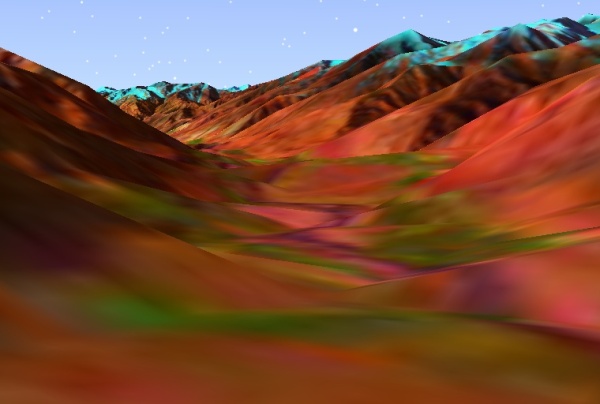
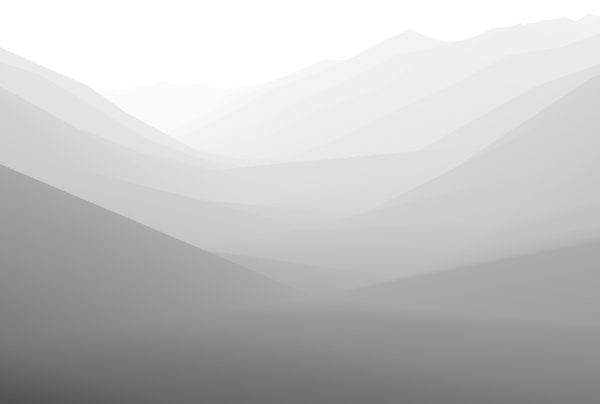

Supported OpenGL States
ColladaFX Element | OpenGL State | Notes |
|---|---|---|
alpha_func | glAlphaFunc | |
alpha_test_enable | glEnable/glDisable with GL_ALPHA_TEST | |
blend_color | glBlendColor | |
blend_enable | glEnable/glDisable with GL_BLEND | |
blend_equation | glBlendEquation | |
blend_equation_separate | glBlendEquationSeparate | Requires OpenGL 2.0. |
blend_func | glBlendFunc | |
blend_func_separate | glBlendFuncSeparate | Requires OpenGL 1.4. |
color_mask | glColorMask | |
cull_face | glCullFace | |
cull_face_enable | glEnable/glDisable with GL_CULL_FACE | |
depth_clamp_enable | glEnable/glDisable with GL_DEPTH_CLAMP_NV | Requires GL 3.2 or GL_ARB_depth_clamps. |
depth_func | glDepthFunc | |
depth_mask | glDepthMask | |
depth_range | glDepthRange | |
depth_test_enable | glEnable/glDisable with GL_DEPTH_TEST | |
fog_color | glFogfv with GL_FOG_COLOR | |
fog_density | glFogf with GL_FOG_DENSITY | |
fog_enable | glEnable/glDisable with GL_FOG | |
fog_end | glFogf with GL_FOG_END | |
fog_mode | glFogi with GL_FOG_MODE | |
fog_start | glFogf with GL_FOG_START | |
front_face | glFrontFace | |
line_smooth_enable | glEnable/glDisable with GL_LINE_SMOOTH | |
line_stipple | glLineStipple | |
line_stipple_enable | glEnable/glDisable with GL_LINE_STIPPLE | |
line_width | glLineWidth | |
point_size | glPointSize | |
point_smooth_enable | glEnable/glDisable with GL_POINT_SMOOTH | |
polygon_mode | glPolygonMode | Only FRONT_AND_BACK. |
polygon_offset | glPolygonOffset | |
polygon_offset_fill_enable | glEnable/glDisable with GL_POLYGON_OFFSET_FILL | |
scissor | glScissor | |
scissor_test_enable | glEnable/glDisable with GL_SCISSOR_TEST | |
shade_model | glShadeModel | |
stencil_func | glStencilFunc | |
stencil_func_separate | glStencilFuncSeparate | Requires OpenGL 2.0. |
stencil_mask | glStencilMask | |
stencil_mask_separate | glStencilMaskSeparate | Requires OpenGL 2.0. |
stencil_op | glStencilOp | |
stencil_op_separate | glStencilOpSeparate | Requires OpenGL 2.0. |
stencil_test_enable | glEnable/glDisable with GL_STENCIL_TEST | |
texture1D | glBindTexture with GL_TEXTURE_1D | |
texture2D | glBindTexture with GL_TEXTURE_2D | |
texture3D | glBindTexture with GL_TEXTURE_3D | |
textureCUBE | glBindTexture with GL_TEXTURE_CUBE_MAP | Requires OpenGL 1.3. |
textureDEPTH | glBindTexture with GL_TEXTURE_2D | Used for depth textures. |
textureRECT | glBindTexture with GL_TEXTURE_RECTANGLE_ARB |
Unsupported OpenGL States
ColladaFX Element | Notes |
|---|---|
auto_normal_enable | |
clip_plane | Can be emulated in the fragment shader. Removed from OpenGL 3.2 core. |
clip_plane_enable | Can be emulated in the fragment shader. Removed from OpenGL 3.2 core. |
color_logic_op_enable | Rarely used. |
color_material | Can be emulated in the fragment shader by implementing a BRDF. Removed from OpenGL 3.2 core. |
color_material_enable | Can be emulated in the fragment shader by implementing a BRDF. Removed from OpenGL 3.2 core. |
depth_bounds | Only affects performance, not the visual output. Not in core GL, requires EXT_depth_bounds_test. |
depth_bounds_enable | Only affects performance, not the visual output. Not in core GL, requires EXT_depth_bounds_test. |
dither_enable | Rarely used. |
light_ambient | Can be emulated in fragment shader. Fixed function lighting was removed from OpenGL 3.2 core. |
light_constant_attenuation | Can be emulated in fragment shader. Fixed function lighting was removed from OpenGL 3.2 core. |
light_diffuse | Can be emulated in fragment shader. Fixed function lighting was removed from OpenGL 3.2 core. |
light_enable | Can be emulated in fragment shader. Fixed function lighting was removed from OpenGL 3.2 core. |
light_linear_attenuation | Can be emulated in fragment shader. Fixed function lighting was removed from OpenGL 3.2 core. |
light_model_ambient | Can be emulated in fragment shader. Fixed function lighting was removed from OpenGL 3.2 core. |
light_model_color_control | Can be emulated in fragment shader. Fixed function lighting was removed from OpenGL 3.2 core. |
light_model_local_viewer_enable | Can be emulated in fragment shader. Fixed function lighting was removed from OpenGL 3.2 core. |
light_model_two_side_enable | Can be emulated in fragment shader. Fixed function lighting was removed from OpenGL 3.2 core. |
light_position | Can be emulated in fragment shader. Fixed function lighting was removed from OpenGL 3.2 core. |
light_quadratic_attenuation | Can be emulated in fragment shader. Fixed function lighting was removed from OpenGL 3.2 core. |
light_specular | Can be emulated in fragment shader. Fixed function lighting was removed from OpenGL 3.2 core. |
light_spot_cutoff | Can be emulated in fragment shader. Fixed function lighting was removed from OpenGL 3.2 core. |
light_spot_direction | Can be emulated in fragment shader. Fixed function lighting was removed from OpenGL 3.2 core. |
light_spot_exponent | Can be emulated in fragment shader. Fixed function lighting was removed from OpenGL 3.2 core. |
lighting_enable | Can be emulated in fragment shader. Fixed function lighting was removed from OpenGL 3.2 core. |
logic_op | Rarely used. |
logic_op_enable | Rarely used. |
material_ambient | Can be emulated in the fragment shader by implementing a BRDF. Removed from OpenGL 3.2 core. |
material_diffuse | Can be emulated in the fragment shader by implementing a BRDF. Removed from OpenGL 3.2 core. |
material_emission | Can be emulated in the fragment shader by implementing a BRDF. Removed from OpenGL 3.2 core. |
material_shininess | Can be emulated in the fragment shader by implementing a BRDF. Removed from OpenGL 3.2 core. |
material_specular | Can be emulated in the fragment shader by implementing a BRDF. Removed from OpenGL 3.2 core. |
model_view_matrix | Can be emulated in the shader. Removed from OpenGL 3.2 core. |
multisample_enable | Requires an OpenGL context be created with multisample buffers, which is currently not supported in Insight3D. |
normalize_enable | This is always enabled. |
point_distance_attenuation | |
point_fade_threshold_size | |
point_size_enable | |
point_size_max | |
point_size_min | |
polygon_offset_line_enable | |
polygon_offset_point_enable | |
polygon_smooth_enable | |
projection_matrix | Can be emulated in the shader. Removed from OpenGL 3.2 core. |
sample_alpha_to_coverage_enable | Requires an OpenGL context be created with multisample buffers, which is currently not supported in Insight3D. |
sample_alpha_to_one_enable | Requires an OpenGL context be created with multisample buffers, which is currently not supported in Insight3D. |
sample_coverage | |
sample_coverage_enable | |
texture_env_color | Can be emulated in the fragment shader. Removed from OpenGL 3.2 core. |
texture_env_color | Can be emulated in the fragment shader. Removed from OpenGL 3.2 core. |
texture_pipeline | GLES profile only. GLSL is currently the only supported profile. |
texture1D_enable | This isn't required when using a texture in a shader. Removed from OpenGL 3.2 core. |
texture2D_enable | This isn't required when using a texture in a shader. Removed from OpenGL 3.2 core. |
texture3D_enable | This isn't required when using a texture in a shader. Removed from OpenGL 3.2 core. |
textureCUBE_enable | This isn't required when using a texture in a shader. Removed from OpenGL 3.2 core. |
textureDEPTH_enable | This isn't required when using a texture in a shader. Removed from OpenGL 3.2 core. |
textureRECT_enable | This isn't required when using a texture in a shader. Removed from OpenGL 3.2 core. |